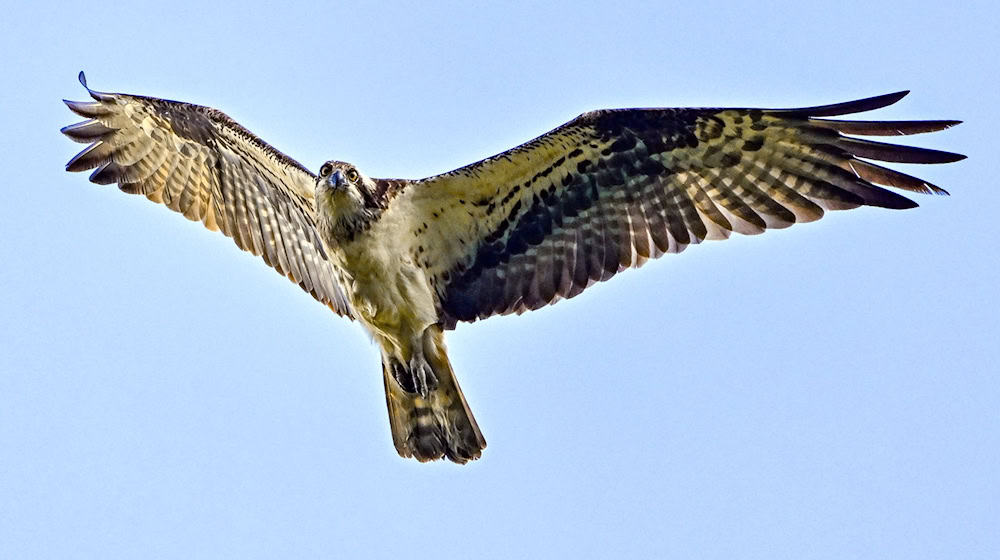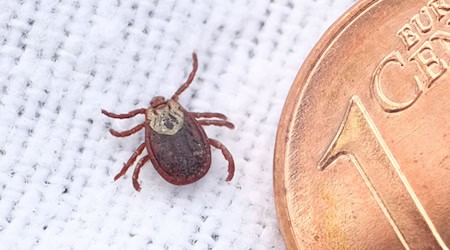The osprey nest is perched a good 20 meters up on the pole of a power line. On this day, the pair of strictly protected birds of prey in Thierfeld are receiving a visit: ornithologists want to ring their offspring. Young birds are given an individual number, a kind of identity card for birds. It is still unclear how many young the only pair of ospreys in the Zwickau district have hatched. Employees of the network operator are now climbing the mast to take a first look inside the eagle's nest.
Ospreys are becoming more common again in Saxony. While 45 to 55 territories were counted in 2013, there were 100 to 110 last year, Karin Bernhardt, spokeswoman for the State Office for the Environment, Agriculture and Geology, told dpa in response to an inquiry. In addition, there are birds that are occasionally observed in the region during migration. However, the breeding grounds in the state are unevenly distributed. The medium-sized bird of prey is particularly at home in water-rich regions such as Lusatia and northern Saxony. As its name suggests, it feeds exclusively on fish.
The birds grow up to 62 centimetres tall and usually build large nests in treetops. In this country, the nests are usually found on electricity pylons, where nesting aids are erected for the birds. They spend most of the winter in Africa and return to their breeding grounds in spring. In Germany, the population is considered endangered.
Protection zones around eagle nests
In Saxony, the occurrence and breeding success of ospreys are documented every year. In addition, nesting aids are provided and temporary protection zones are set up around the nests so that the birds are not disturbed while breeding. In addition to the osprey, the white-tailed eagle also breeds in Bavaria - both are protected to the highest standards. According to Bernhardt, there are currently 85 to 95 known territories of the white-tailed eagle, mainly in Upper Lusatia. Lesser spotted eagles and short-toed eagles can also be observed here as rare guests or migrants.
Ospreys mating were first observed in Thierfeld in 2012, according to Jens Hering, bird conservation expert at the Zwickau district office. As a result, a nesting aid was erected, and in 2016 the first successful brood was established. "We would never have believed that ospreys would breed here." On average, one to two young are raised, in good years even three, reports Hering.
In the meantime, the helpers have discovered a handsome youngster in the eyrie, put it in a bag and lowered it down on a rope. On the ground, ornithologist Rico Spangenberg weighs the young bird, measures its wings and then puts a ring on each leg. According to the experts, it is impossible to tell whether it is a boy or a girl. The ring can later be used to identify it using a telescope, for example. "We can therefore say that its father was ringed as a chick in northern Saxony in 2020," explains Spangenberg. He estimates that the young bird is around 50 days old and will fledge in just over a week. It will begin its long journey to its wintering grounds in Africa in August.
The bird quickly survives the procedure and then heads back up to the eyrie. Not far away, one of the parent birds is already circling impatiently.
Racons and drones a problem for birds
A total of around 180 bird species breed in Saxony every year, with isolated breeding records of around a dozen more. Almost 40 percent are considered endangered, as Karin Bernhardt from the State Office for the Environment explains. These include lapwing and snipe, whinchat, meadow pipit, partridge and the ortolan. The tawny pipit and wheatear, which benefited from opencast lignite mining in past decades, are also included. They are at home in post-mining landscapes, but the habitats are becoming smaller and smaller due to natural changes in the landscape and new land uses.
A growing problem for bird conservation is the spread of the raccoon, explains Bernhardt. This is because raccoons scavenge nests on the ground and in trees. Another problem is that birds are disturbed by drones when breeding and rearing their young, adds ornithologist Hering. "That's a huge problem." Curious people without any sense would sometimes steer their drones close to the nests and cause birds to panic.
Some bird species have already become extinct as breeding birds in Saxony in recent decades. According to the authorities, these include the capercaillie, the Eurasian curlew and the black-tailed godwit.
Hering confirms that good conservation measures have allowed the numbers of ospreys and white-tailed eagles to grow in Saxony. However, we should not rest on our laurels. "That can quickly change again." There is also room for more breeding pairs in Thierfeld: just a few electricity pylons away, a second nesting aid is waiting to be occupied by a pair of eagles.
Copyright 2024, dpa (www.dpa.de). All rights reserved










